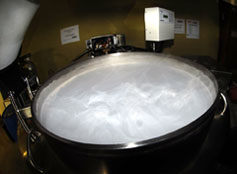Time is slowing down—way down—for a select collection of DNA specimens at the Florida Museum of Natural History. They are housed in a double-walled cryogenic freezer at minus 196 degrees Celsius (minus 320.8 degrees Fahrenheit), which staves off the degrading powers of heat, moisture and light that steal away DNA’s molecular clues about life, biodiversity and evolution.
The freezer is the central component of the Florida Museum’s Genetic Resource Repository project which centralizes the genetic samples and provides them with long term storage. In essence, it is a deeply frozen DNA library.
“As we all know, the colder something is, the slower the pace of its decay,” said project director Andres Lopez, who is also an assistant scientist in the Museum’s Ichthyology Division. “That principle extends down to gene molecules. Heat and humidity are the primary enemies we fight when trying to preserve intact biological molecules for the long term. If we’re able to remove the water or use a deep freezing process, or both, we can significantly slow the decay.”
If you pop the lock on the repository’s cryogenic freezer, wet with condensation, and peek inside, you’ll spy row after row of more than 5,000 vials. Each one contains tiny bits of animal and plant tissue. Most samples are smaller than your pinky fingernail. The freezer has room for 75,000 more.
“These samples contain biological information that we don’t yet have in our current books or in more traditional museum holdings,” Lopez said.
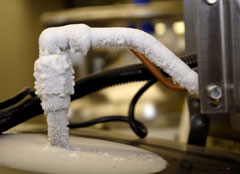
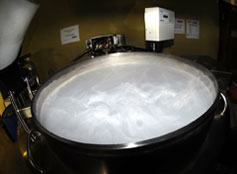
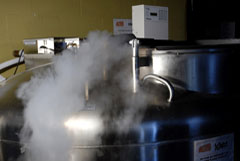
How it works
About 5- to 8-inches of liquid nitrogen in the freezer’s base, just below the lowest specimen rack, maintains the cryogenic environment. The nitrogen evaporates at a fairly constant rate (its boiling point is minus 195.8 degrees Celsius or minus 320.4 degrees Fahrenheit) and as the vapors waft upward, they chill the specimens on a gradient, rising to a balmy minus 180 degrees Celsius (minus 292 Fahrenheit) at the container’s uppermost racks. But constant evaporation means the liquid must be regularly replenished, so a computer sensor ensures the nitrogen does not drop below a depth of 5 inches.
When it does, once every eight days or so, a valve clicks open and liquid nitrogen pours from a reserve tank into a hose that delivers it into the freezer’s base. The liquid nitrogen boils instantly when it hits the room-temperature hose, and loud hissing, humming and gurgling noises ensue. The incoming liquid forces extra air and vapor up through the container until it pours out like an undulating white fountain of steam from a vent in the lid. For a few hours during this process, the stout 5-foot by 4-foot silver vat looks like something about to blast off in a science fiction space movie.
Contrasted with its high-tech appearance, Museum scientists use a fairly low-tech process for prepping specimens for storage: they simply snip off a bit of tissue and place it in a small plastic vial. The tissue could be part of a toe pad from a lizard, a few square millimeters of a butterfly’s wing, heart muscle from a bird or strips of liver from a Florida panther.
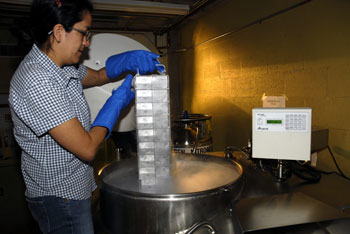
Photo by Jeff Gage
Small samples, lots of information
Despite their miniscule size, each sample contains profoundly deep layers of information. But this information is also meaningless unless it remains associated with the original specimen—which is linked to records about what it is, who found it, and where and when it was discovered.
Lopez says a database, which is available online, logs the stored samples and associates them with the original specimens. The bulk of samples currently stored are from the Museum’s neontological collections, or those collections that focus on recent or living species as opposed to extinct or fossil species.
Frozen tissue snips are from birds, marine invertebrates, fishes, Neotropical orchids and mammals. Fish samples are primarily snips from fins, and orchid samples are primarily from flowers, leaves and DNA extractions. Most of the mammal samples are of liver, kidney and muscle tissues from Florida panthers, obtained from specimens donated to the Museum by the Florida Fish and Wildlife Conservation Commission. David Reed, the Museum’s assistant curator of mammalogy, said certain tissues are targeted for their DNA potential.
“Liver and kidney tissues tend to be very rich in mitochondrial DNA, so we prefer those tissues,” Reed said. “Muscle tissue, whether it’s from the heart or not, tends to provide good nuclear DNA too. Sometimes blood is collected when other tissue samples cannot be taken, however blood is less desirable, especially for mammals since mammalian red blood cells lack nuclear DNA”
Just a small amount of tissue is needed because scientists can perform polymerase chain reaction, or PCR, tests which allow them to amplify and replicate targeted DNA sequences so that an abundance of a certain sequence is generated from one sample. This not only allows extensive study of the sequence but also means they can store a smaller volume of any given tissue sample.
The cryogenic freezer also improves researchers’ work flow and access to specimens.
“Before, everyone stored their own DNA samples, so the storage sites were scattered all over the building,” Reed said. “And some people used ultra-cold freezers, which only go down to about minus 85 degrees Celsius (minus 121 Fahrenheit), while others used conventional freezers, which are even worse for the stability of the specimen. Now, all of our DNA samples are safely housed together.”
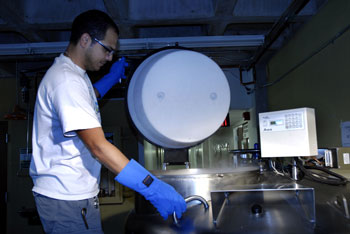
Photo by Jeff Gage
Future potential for DNA techniques is great
In the past, scientists described evolutionary relationships largely on the basis of taxonomy and morphology, which focus on an organism’s physical traits. But the emergence and refinement of DNA studies offers a high-powered and insightful tool into how organisms are related genetically on the tree of life and how related species evolved over time.
Yet for all their power, DNA techniques are still in their infancy. And to a scientist accustomed to thinking in terms of geologic time scales, on the order of tens of millions of years, it’s not far-fetched to think that DNA techniques 100 years from now may offer deeper insight—of an unimaginably finer-grained resolution—into how life evolved on earth. And so it makes sense to take great care conserving today’s specimens for tomorrow’s scientists.
“The best part of having the Genetic Resources Repository with its own curator and collection staff is that they can focus on the questions relating to best storage practices for frozen samples in order to maximize future research potential,” Reed said. “If I, as curator of mammals, had to do that on top of other responsibilities, I would likely fail to keep up at some point. But our GRR team can maximize the research potential of these specimens for generations to come, and although we can’t even imagine some of the uses that will exist in the next 50 years, these samples should be around long after that.”
